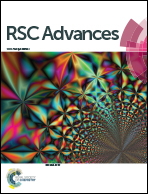Naphthalimide-based fluorescent photoinduced electron transfer sensors for saccharides†
Abstract
The design and synthesis of two novel fluorescent sensors based on the photoinduced electron transfer (PET) mechanism for the detection of saccharides in aqueous medium is described. These sensors are based on the 4-amino-1,8-naphthalimide fluorophore, which absorbs and emits at ∼400 nm and ∼530 nm, respectively. By incorporating a phenylboronic acid receptor at the 4-position through a piperazine linker, high sensitivity was achieved for the sensing of saccharides. Both probes showed pH-dependent fluorescence intensities, with pKa values of 4.8 (PET-S1) and 4.4 (PET-S2), respectively. After binding with sugars, up to 50-fold and 5-fold fluorescence enhancements for PET-S1 and PET-S2 were observed at pH 7.4, which allows them to be used under physiological conditions. The switch-on responses of both probes toward saccharides demonstrating the suppression of PET from the amino group to the fluorophore. The probes showed high sensitivity towards D-fructose and D-sorbitol. Probe PET-S1 was used to detect fructose in honey and beverages with good recovery.


 Please wait while we load your content...
Please wait while we load your content...